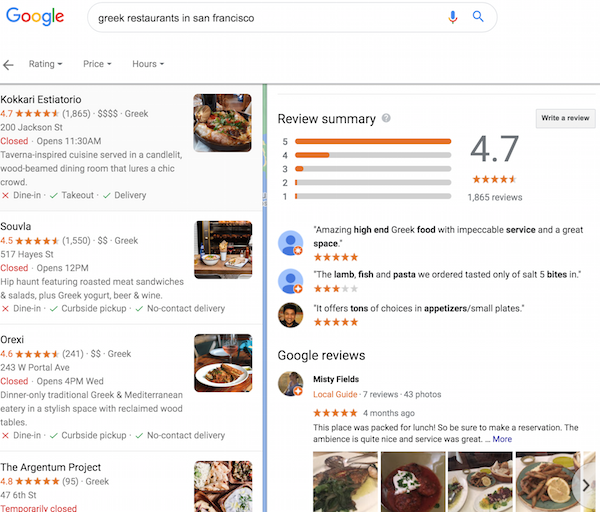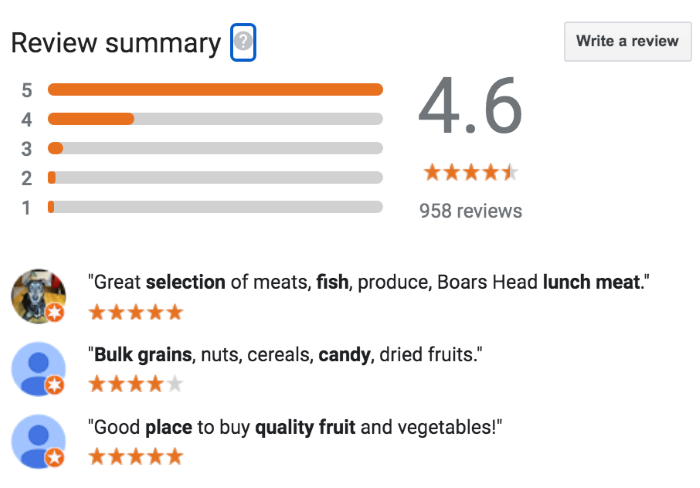
What are Google review summaries, and how do they impact consumers’ view of your brand?
First impressions matter. When people search for a business or your specific business name on Google, one of the first things they see is your Google listing and the corresponding reviews.
Those reviews, positive or negative, impact how they view your brand.
What others have to say about your brand could impact how people perceive your brand. It could help them decide if they want to do business with you or not.
It could encourage them to give you a call, visit your website, or stop by your local shop. Or it may encourage them to keep looking for a business with better reviews.
Let’s talk more about Google review summaries and what they mean for your company.
Intro to Google Review Summaries
Google review summaries are the snippets of three customer reviews for your brand. Using an algorithm, Google automatically chooses three reviews to highlight.
They are called summaries, because they are just one or two lines pulled from a full review. To read the whole review, searchers can click on the summary.
Those three review summaries may be positive reviews, negative reviews, or a mixture of those.
Where Do Your Google Review Summaries Appear?
It starts in the Google Knowledge Panel.
Even if you aren’t familiar with that name, you probably are still familiar with the Google Knowledge Panel. It is the box of information that shows up in a Google search when you look for a particular brand, especially local or location-based businesses.
The Google Knowledge Panel includes descriptive information, business address, location on a Google map, contact information, website, hours of operation, questions and answers, popular times, photos, social media profiles, and popular web results.
It also includes the Google review summaries. The summaries can be found about midway down the Google Knowledge Panel, below the photos.
Looking for Google Review Summaries
When you search for a local business, such as a store, restaurant, office building, medical practice, and more, Google provides a listing of local options. When you click on one example, the Google Knowledge Panel is displayed.
That will provide the Google review summaries.
You can also search directly in Google Maps. Pull up Google Maps to search your current location or type in the area you want to search. Then type in the brand or type of place you’re looking for.
When you click on each option, you’ll see the Google Knowledge Panel. Scroll down to see the review summaries.

How Place Topics Shape Google Review Summaries
Place topics are an element of the Google review summary algorithm that highlights popular keywords related to your brand’s reviews.
They cannot be chosen by the brand owner, or by reviewers. They are simply generated automatically by Google, if a brand has enough reviews. Although according to Google, that threshold number is not specified.
Here’s an example of place topics in a Google review summary for a grocery store. You’ll see some of the highlighted topics are insightful, such as “lunch meat” while others are rather generic.
This speaks to the automated algorithm that just pulls in commonly used phrases.

These are more useful when many reviewers speak about a certain product or service, or other phrase that helps viewers understand more about what makes a brand unique.
Where Google Review Summaries Come From
They come from Google reviews that are submitted by users on Google maps. Those who have visited a specific location can log in to their Google account, find a place on Google maps, and choose to submit a review and star rating.
Google review summaries are pulled from those reviews.
How Impactful Are Google Review Summaries?
These review summaries can impact how customers perceive your brand, even before they contact you or stop by your location.
They could decide to scroll by or click on a competitor, if they aren’t seeing reviews that impress them. Alternatively, they may choose to click on your website, check out your location, or contact you directly to get more information about your brand.
Do reviews really matter to customers?
The statistics say yes. In general, reviews influence buyers. Almost 90 percent of buyers read reviews to make their buying decisions, according to BrightLocal. According to that same report, a majority are only impacted by reviews written in the last three months. A large portion of those same consumers only consider reviews written in the last two weeks.
A quarter of consumers look to customer reviews with every online purchase they make, according to this PowerReviews report.
It’s not just the words that Google highlights in the reviews that people read in the summaries. A big factor in people making decisions about your brand is the star factor. The star ratings make Google review summaries stand out.
According to this report, over half of consumers say that a star rating is the most important review factor. A large majority say that a trust-worthy brand should have three or more stars in a five-star system, like Google reviews.
So yes, reviews do impact buyer behavior and your brand’s reputation. But there’s more to the Google review summaries than the impression they leave on consumers.
They can also have an impact on SEO.
According to this report, reviews actually aid in your search engine optimization strategy. Although they are only a part of an SEO strategy, reviews help with creating more generated content and rank for the right keywords.
In addition to those Google reviews that support SEO, you can continue to boost that by responding to Google reviews.
Google also stated that interacting with consumer Google reviews for your brand can improve visibility. In other words, staying up-to-date in responding to reviews can improve your SEO.
That means more people will see your brand, see those Google review summaries, and hopefully leave reviews so you can respond. Reviews actually create a cycle of more reviews and better SEO.
How to Get Positive Google Review Summaries
By design, Google reviews and Google review summaries are not something business owners have direct control over. Otherwise, everyone would go in and manipulate things to shed the best light on their business!
Does that mean that getting positive reviews is completely outside your direction? Not at all.
The best thing you can do is to run a business with the customer in mind. It sounds obvious, but it’s truly the best way to get the positive feedback you’re hoping for.
In our busy world, it’s easy to lose sight of the customer, but at the end of the day, they control not only the reviews, but also your income.
Sometimes, the old adage really does need to ring true: the customer is always right.
Ensure Customers Have a Good Experience
The first step is to audit the entire customer service experience. This can be a part of your overall brand audit.
Think about every touch point your customers have with your business, from first learning about your products and services, to asking questions, to purchasing, and the follow up.
Take a step back and dig deep. Ask the hard questions. Are you still offering a quality product? Are you still meeting a market need? If you aren’t getting rave reviews, it may be time to make some tweaks to ensure you are providing products and services your target market really needs.
Ask for Reviews
It’s simple, but effective.
To get more Google reviews, sometimes all you need to do is ask. There are lots of ways to convince your customers to review your brand, but just asking is a good place to start. You can include a link to your Google location in an email or social media post, encouraging happy customers to share their feedback.
Ask your most loyal customers to leave feedback. Those who are most satisfied with your product or services are often eager to share that happiness with others and are most likely to provide positive reviews.
Of course, keep in mind that you can’t tell them what to say, and even your happiest customers may be painfully honest about a less-than-ideal experience they had with you or a bad day with your product or service.
That’s why the first tip is the most important. Always look for ways to provide the best service you can.
Respond to Google Reviews (Good and Bad!)
Keep the good vibes going. When people respond well with positive reviews, you can hop in there and thank them. Responding to Google reviews adds to your social proof and brings some humanity to your brand.
Don’t just wait for negative reviews to respond, as we will discuss below. Encourage more positive reviews by showing that you really are reading reviews and taking them to heart.
What to Do When You Have Negative Google Review Summaries
Like it or not, negative reviews happen.
In a customer-driven system like Google review, you don’t have full control over what is posted about your brand. In fact, negative reviews can be a good thing—they show your brand is real.
When those bad reviews happen, here’s how to respond.
First, Relax
No one wants to hear bad news about their brand, especially when you work hard to provide a great experience, as we talked about above.
But there’s hardly a business owner who hasn’t come up against this kind of conflict. The first thing to do is take a deep breath and understand that businesses need negative reviews. They add to the authenticity of your brand.
Consumers understand that not everyone is going to have a perfect experience with every brand.
Put It in Perspective
Sometimes negative reviews can shine light on positive aspects of your brand.
When a customer reads a review about how something didn’t work for them, for instance, other customers can learn more about what you do offer.
Imagine a customer complaining that they couldn’t find a meat option at your vegetarian restaurant. It’s an exaggerated example, but shows how a negative review could be a positive for some readers.
Decide How to Act
Have a “negative review plan” in place, well before your first one rolls in. It’s important to remember the reputation you want your business to have, and to keep the long game in mind. Google recommends responding quickly, honestly, and with a level of positivity.
If you think a review is inappropriate or violates Google’s policies, if it’s particularly vile, etc., you can request that it be removed. Remember, you can’t just have a review removed because you disagree with it or don’t want it out there.
Think About the Ratios
There’s no perfect number of reviews for everyone, but when it comes to reviews think about the ratios. One bad review isn’t going to hurt you if you have dozens of positive reviews.
To get an idea of how you’re doing, think like a customer. How will they read the negative reviews in light of your positive ones? Would one negative review impact your buying decision? In most cases, one or two bad reviews (especially if they are several months old) won’t impact your brand.
Conclusion
Google review summaries are social proof. They give your brand authenticity and shed light on your company when people Google you.
These kinds of online reviews help customers understand what you’re all about and how you’ve helped people in the past. To improve the quality of your Google review summaries, start by working to get more online reviews.
Don’t forget the power of responding to reviews—whether they are good or bad. Customers expect some bad reviews, but how you respond can make all the difference.
How do Google review summaries help you make purchasing decisions?
The post What are Google Review Summaries? appeared first on Neil Patel.
No comments:
Post a Comment